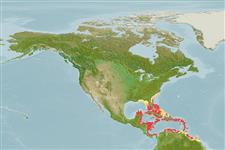>
Clupeiformes (Herrings) >
Dorosomatidae (Gizzard shads and sardinellas)
Etymology: Harengula: Old English haring, hering = mackerel, the fish Clupea harengus (Ref. 45335).
More on author: Cuvier.
Environment: milieu / climate zone / depth range / distribution range
Écologie
marin récifal; profondeur 0 - 50 m (Ref. 188). Subtropical; 34°N - 4°N, 90°W - 52°W (Ref. 188)
Western Atlantic: Bermuda, Florida (USA), Bahamas, Caribbean, Guianas (but no records to the south of this; no Brazilian specimens in the extensive collections of the Museu de Zoologia, Sao Paulo, Brazil).
Length at first maturity / Taille / Poids / Âge
Maturity: Lm 11.0, range 9 - ? cm
Max length : 22.0 cm TL mâle / non sexé; (Ref. 26340); common length : 15.0 cm TL mâle / non sexé; (Ref. 5217)
Épines dorsales (Total): 0; Rayons mous dorsaux (Total): 13-21; Épines anales 0; Rayons mous anaux: 12 - 23. Tooth plate on tongue and tooth plate behind it (basihyal and basibranchial tooth plates) very narrow, their width about 10 times in combined length, the basihyal tooth plate not bulging in front. Scales thin, loosely attached, easily shed. Tips of anterior dorsal fin rays dark. Reddish or orange spot behind upper end of gill (Ref. 26938). Body slender, with evenly curved upper and lower profiles (Ref. 7251).
Occur in coastal waters, usually along the shoreline (Ref. 9710) and over clear coral reefs (Ref. 5217). May form large schools in beaches, mainly over Thalassia beds (Ref. 5217). Often in polluted areas (Ref. 9710).
Life cycle and mating behavior
Maturité | Reproduction | Frai | Œufs | Fécondité | Larves
Whitehead, P.J.P., 1985. FAO Species Catalogue. Vol. 7. Clupeoid fishes of the world (suborder Clupeoidei). An annotated and illustrated catalogue of the herrings, sardines, pilchards, sprats, shads, anchovies and wolf-herrings. FAO Fish. Synop. 125(7/1):1-303. Rome: FAO. (Ref. 188)
Statut dans la liste rouge de l'IUCN (Ref. 130435)
Utilisations par l'homme
Pêcheries: commercial; appât: usually
Plus d'informations
RéférencesAquacultureProfil d'aquacultureSouchesGénétiqueElectrophoresesHéritabilitéPathologiesTraitementNutrientsMass conversion
Outils
Articles particuliers
Télécharger en XML
Sources Internet
Estimates based on models
Preferred temperature (Ref.
123201): 24.5 - 28, mean 26.7 °C (based on 104 cells).
Phylogenetic diversity index (Ref.
82804): PD
50 = 0.5625 [Uniqueness, from 0.5 = low to 2.0 = high].
Bayesian length-weight: a=0.00977 (0.00606 - 0.01577), b=3.06 (2.93 - 3.19), in cm total length, based on LWR estimates for this species & (Sub)family-body (Ref.
93245).
Niveau trophique (Ref.
69278): 3.4 ±0.1 se; based on diet studies.
Generation time: 2.7 ( na - na) years. Estimated as median ln(3)/K based on 2
growth studies.
Résilience (Ref.
120179): Haut, temps minimum de doublement de population inférieur à 15 mois (K=0.41-1.03; tm=1.5; Fec=41,000).
Fishing Vulnerability (Ref.
59153): Low vulnerability (14 of 100).
Nutrients (Ref.
124155): Calcium = 61.6 [28.5, 116.2] mg/100g; Iron = 1.07 [0.53, 1.98] mg/100g; Protein = 20 [19, 21] %; Omega3 = 0.348 [0.190, 0.650] g/100g; Selenium = 17.1 [8.4, 38.4] μg/100g; VitaminA = 53.8 [17.1, 175.0] μg/100g; Zinc = 0.913 [0.586, 1.427] mg/100g (wet weight);
